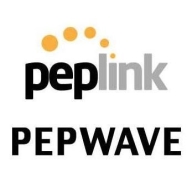


VMware VeloCloud SD-WAN and Peplink SpeedFusion are two prominent SD-WAN technologies. VMware VeloCloud SD-WAN is favored for its advanced features, while Peplink SpeedFusion is recognized for its robust reliability and performance.
Features: VMware VeloCloud SD-WAN is noted for its high scalability, dynamic multipath optimization, and strong integration capabilities. Peplink SpeedFusion offers unique features such as enhanced VPN bonding, unbreakable connectivity with failover, and extensive control over traffic management.
Room for Improvement: Users suggest VMware VeloCloud SD-WAN could benefit from better documentation and enhanced customer support. Peplink SpeedFusion users recommend improvements in cloud integration and a more intuitive management dashboard.
Ease of Deployment and Customer Service: VMware VeloCloud SD-WAN is generally praised for its seamless deployment and wide customer service options. Peplink SpeedFusion users find the installation straightforward but a bit more time-consuming and cite excellent customer service.
Pricing and ROI: VMware VeloCloud SD-WAN is seen as more expensive but delivers high ROI with its comprehensive feature set. Peplink SpeedFusion, while more cost-effective, often requires additional investments for similar functionality.
Clients are now comfortable and not wasting productive hours on IT support.
We have experienced a positive return on investment by utilizing Fortinet's products.
There's definitely an ROI. Having a centralized way of managing and applying policies across the entire organization always helps.
The deployment time with VMware VeloCloud SD-WAN saves 50 percent compared to traditional MPLS networks.
He explained that it required a command line configuration, as it couldn't be done through the graphical user interface.
I would rate their support for FortiGate a nine out of ten.
They offer very accurate solutions.
I appreciate having dedicated service engineers who manage our account and ensure any technical issues are addressed efficiently.
They scale up really well from smaller models like the FortiGate 40 and 50 to bigger sites with the FortiGate 100 for more throughput - up to enterprise datacenters.
The variation comes in terms of the interfaces and throughputs, but from a security perspective, you get the same benefit, irrespective of whether you have an entry-level unit or an enterprise.
You can choose a cheaper model if you only have 20-30 users, but you will need to spend more money for a FortiGate solution that covers 5,000.
The customer base for VMware VeloCloud SD-WAN has been growing 30 to 40 percent per year when transitioning from traditional MPLS networks.
Improper handling of these can lead to a memory surge, a well-known bug that can cause the entire system to freeze.
It is less stable than Palo Alto Networks and Check Point firewalls because there are lots of bugs in the latest firmware.
We have not had any problems with the operating systems or maintenance of subscriptions.
The technical team from VMware VeloCloud SD-WAN addresses these issues promptly, making us very happy with their support.
If I have put 10 GBPS of throughput on a firewall and I enable all of these features available, such as IPS or UTM functionalities, the throughput comes down to 1 GBPS.
By providing an integrated solution, users would have access to all features and functionalities within a single window, eliminating the need to navigate through multiple windows.
Investing in a solution that can accommodate such growth would be more cost-effective than repeatedly purchasing new hardware.
I would like to see improved security features, such as adding more SASE functions.
Secure SD-WAN is free of charge.
The most expensive part is the renewal of the license subscription.
FortiGate is priced lower than Palo Alto.
The pricing is high, making the margin thin, which limits mark-up opportunities from the wholesale price.
The firewall, IPS, and VPN functions are the most valuable features.
FortiGate provides solid protection against viruses, malware, and other threats.
Within the same dashboard, you get to see the security profiles, the type of traffic that's passing through, the top applications that are being consumed, etc.
Its proprietary Dynamic Multipath Optimization (DMP) technology is regarded as the most powerful and valuable function by VMware VeloCloud SD-WAN.



Fortinet FortiGate offers comprehensive network security and firewall protection across multiple locations. It effectively manages data traffic and secures environments with features like VPN, intrusion prevention, and UTM controls.
Organizations rely on Fortinet FortiGate for its robust integration with advanced security policies, ensuring significant protection for enterprises, cloud environments, and educational sectors. It facilitates network segmentation, application-level security, and authentication management, securing communication within and between locations such as branches and data centers. Its efficient SD-WAN and UTM features enable streamlined data management and enhanced threat protection capabilities. Users appreciate its centralized management, facilitating seamless operations across diverse environments.
What are the key features of Fortinet FortiGate?
What benefits should users expect from Fortinet FortiGate?
Fortinet FortiGate is crucial in sectors like education, offering robust networks for secure data flow between campuses and facilitating remote learning. In enterprise environments, it allows efficient management of application traffic and security across multiple branches, while in the cloud, it seamlessly integrates with diverse platforms to enhance security infrastructure.
Peplink’s patent-pending SpeedFusion technology powers enterprise VPNs that tap into the bandwidth of up to 13 low-cost cable, DSL, 3G/4G/LTE, and other links connected anywhere on your corporate or institutional WAN. Whether you’re transferring a few documents or driving realtime POS data, video feeds, and VoIP conversations, SpeedFusion pumps all your data down a single fat datapipe that’s budget-friendly, ultra-fast, and easily configurable to suit any networking environment.
VMware Software-Defined Wide Area Network (SD-WAN) is a secure access service edge (SASE) platform that combines many types of software-based network technologies in an attempt to enable users to virtualize their wide area networks and reduce their reliance on hardware. In essence, this solution makes it possible for users to reliably access their applications from anywhere in the world by leveraging cloud technologies. Users can simply, efficiently, and completely control their network devices and traffic. It ensures that organizations are always able to use the best possible connection to their data centers. VMware SD-WAN steers traffic so that it is always using the most reliable connections and at the same time takes steps to remediate any problems that it detects in other network links. This guarantees that organizations can access high-priority applications at all times.
VMware SD-WAN Benefits
Some of the ways that organizations can benefit by deploying VMware SD-WAN include:
VMware SD-WAN Features
Reviews from Real Users
VMware SD-WAN is a solution that stands out when compared to many of its competitors. Two major advantages it offers are its ability to automate the process of creating and maintaining a virtual local area network and its intuitive user dashboard.
Sami I., principal cloud architect at Loihe, writes, “One of the solution's most valuable features is the VMware core automation stack at an SDDC. It includes NSX, the VMware virtualization layer for the networks (the LAN virtualization), which works extremely well with the VMware SD-WAN solution and is the primary advantage over all the others. None of the other vendors could integrate with the virtual LAN, making it quite complicated and virtualized to be fully automated.”
Chih S., senior technical consultant at a tech services company, says, “The product has a very good user dashboard that is simple to navigate.”
We monitor all Software Defined WAN (SD-WAN) Solutions reviews to prevent fraudulent reviews and keep review quality high. We do not post reviews by company employees or direct competitors. We validate each review for authenticity via cross-reference with LinkedIn, and personal follow-up with the reviewer when necessary.